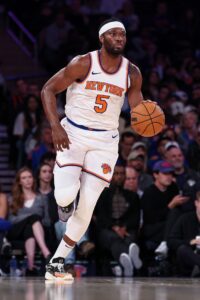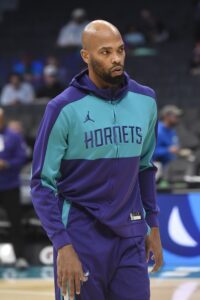The term “tax variance” doesn’t technically show up in the NBA’s Collective Bargaining Agreement, but it’s used colloquially to refer to instances in which a team’s salary for the purposes of calculating its end-of-season luxury tax bill diverges from its standard salary relative to the cap.
This can occur for a number of reasons, including player suspensions, incentives being met (or not), and certain free agent signings. Here’s a breakdown of how each of those occurrences affect a team’s salary for tax purposes:
Suspensions
When a player is suspended by the NBA, he forfeits a percentage of his salary. That percentage ranges from as low as 1/174th for a standard one-game suspension to as high as 1/91.6th for a suspension related to a failure to render services.
In each instance, a team receives a tax variance credit for 50% of the player’s forfeited salary. That means that if a player loses $1MM as a result of a suspension, his team receives a tax variance credit worth $500K.
That amount doesn’t come off the player’s cap hit or the standard team salary, which remain the same for the rest of the season. But for the purposes of calculating a team’s tax bill at the end of the season, the club’s total taxed salary is reduced by $500K as a result of the suspension.
The tax variance credit doesn’t apply to a suspension imposed by the player’s team, since it could open the door for clubs to try to reduce their tax bills or duck the tax entirely by suspending their players.
 A player still forfeits a portion of his salary when he’s suspended by his team (subject to appeal), but his team doesn’t generate any cap or tax savings.
A player still forfeits a portion of his salary when he’s suspended by his team (subject to appeal), but his team doesn’t generate any cap or tax savings.
For instance, when the Heat suspended Jimmy Butler for seven games, it cost him $2,355,798 (7/145ths of his $48,798,677 salary), but it didn’t change Miami’s cap or tax situation at all.
Unlikely incentives that are earned / Likely incentives that go unearned
When a player’s contract includes incentives, they’re considered either “likely” or “unlikely” to be earned. Likely incentives count toward a player’s cap hit for that season, while unlikely incentives don’t.
An incentive is deemed likely or unlikely based on whether or not the player and/or his team met the incentive criteria the previous season. So if a player’s contract calls for a bonus if his team wins the title, he’s considered “likely” to earn it if his team won the championship the year before — even if, in reality, his team isn’t literally likely to repeat.
Here’s a more detailed example. Let’s say a player has a $20MM annual base salary, plus a $1MM incentive if his team wins at least 40 games, another $1MM incentive if his team makes the playoffs, and a third $1MM incentive if he appears in at least 65 games.
If the player appeared in 70 games the prior season and his team finished 41-41, missing the playoffs, he would’ve earned two of those three $1MM bonuses. That means that for the subsequent season, his cap hit would be $22MM, with $2MM in likely incentives counting against the cap and $1MM in unlikely incentives not counting toward his cap charge.
That $22MM is the player’s cap hit for the rest of the season, but his team is subject to tax variance depending on whether or not he earns those incentives again. If the player appears in just 50 games and his team wins 35, missing the postseason, he’d miss out on all three bonuses and his team would receive a tax variance credit of $2MM for the two likely incentives he didn’t end up earning.
Conversely, if the player stays healthy, appears in 75 games, and leads his team to a 50-win season and a playoff berth, he’d earn all of his incentives, including the $1MM that had been considered unlikely. That tax variance would be taken into account for the team, with $1MM being added to its salary for the purposes of calculating its tax bill.
If we assume our hypothetical team entered the season with its player counting toward the cap for $22MM and its total salary at $180MM, tax variance could result in that total ending up as low as $178MM or as high as $181MM by the end of the season, which could significantly change the team’s final tax payment.
Signings of free agents with fewer than two years of NBA service
A rookie’s minimum salary is significantly less than that of a veteran player. But a team looking to duck the tax while filling out its back-end roster spots can’t simply sign a handful of rookie free agents to maximize its savings.
When a player with fewer than two years of NBA service signs a free agent contract worth less than a two-year veteran’s minimum salary, tax variance applies — for tax purposes, that player counts for the same amount that a two-year veteran on a minimum deal would.
The rookie minimum salary for 2024/25 is $1,157,153, whereas the minimum for a two-year veteran is $2,087,519. If a team signed a rookie free agent to a minimum-salary contract this season, that player’s salary and cap hit would be just $1,157,153, but he would count for $2,087,519 toward the tax.
If that player signed a two-year, minimum-salary contract, his salary and cap hit in 2025/26 would be $1,955,377, but he’d count for $2,191,897 toward the tax (those figures can be found in the second column of our minimum-salary chart).
Because this tax variance only applies to free agents, teams can avoid it by signing a rookie draft pick to a minimum-salary contract. That’s why we often see taxpaying clubs prioritize second-round picks — they can use those selections to draft a player who will sign a rookie minimum contract and actually have that modest rookie-minimum figure count for tax purposes. Tyler Smith of the Bucks and Oso Ighodaro of the Suns are a couple 2024 second-rounders on second-apron teams who fall into this category.
It’s worth noting that the same rule applies when a team is converting a player to a standard contract from a two-way deal. If the player was initially signed as a draft pick, tax variance won’t apply to him. If he signed as a free agent, it will.
This is why the Knicks, when they were looking to remain below their hard cap while filling out their roster back in the fall, had the option to convert Ariel Hukporti or Kevin McCullar (both 2024 second-rounders) from two-way deals to rookie-minimum contracts to stay below the hard cap, but couldn’t do so with Jacob Toppin, who signed initially as a free agent. Tax variance would’ve applied to Toppin, who would’ve counted for tax (and apron) purposes as if he were a veteran free agent, even though he only had one year of NBA service on his résumé.
New York ultimately converted Hukporti, whose prorated minimum deal is worth just $1,064,049 for cap, tax, and apron purposes.
Note: This is a Hoops Rumors Glossary entry. Our glossary posts will explain specific rules relating to trades, free agency, or other aspects of the NBA’s Collective Bargaining Agreement. Information from ESPN’s Bobby Marks was used in the creation of this post.
 What does that mean in practical terms? Let’s use Knicks center
What does that mean in practical terms? Let’s use Knicks center 

 It’s no surprise that a No. 2 overall pick like Sarr is in contention for that honor, but his stat line through 34 professional contests isn’t exactly what you’d expect from the Rookie of the Year frontrunner: 11.7 points, 6.6 rebounds, 2.3 assists, and 1.6 blocks in 27.1 minutes per night, with a shooting line of .406/.325/.641.
It’s no surprise that a No. 2 overall pick like Sarr is in contention for that honor, but his stat line through 34 professional contests isn’t exactly what you’d expect from the Rookie of the Year frontrunner: 11.7 points, 6.6 rebounds, 2.3 assists, and 1.6 blocks in 27.1 minutes per night, with a shooting line of .406/.325/.641. Although his numbers, including 5.8 points per game on .359/.318/.750, don’t look especially strong, Ball is once again making the sorts of winning plays that don’t show up in the box score. Chicago has a +6.9 net rating when he’s on the court, compared to a -5.0 mark when he’s not.
Although his numbers, including 5.8 points per game on .359/.318/.750, don’t look especially strong, Ball is once again making the sorts of winning plays that don’t show up in the box score. Chicago has a +6.9 net rating when he’s on the court, compared to a -5.0 mark when he’s not.
 All three of these players were on minimum-salary contracts. Carlson is a rookie who was signed well after the regular season began, which is why his cap hit is so modest compared to the others.
All three of these players were on minimum-salary contracts. Carlson is a rookie who was signed well after the regular season began, which is why his cap hit is so modest compared to the others.